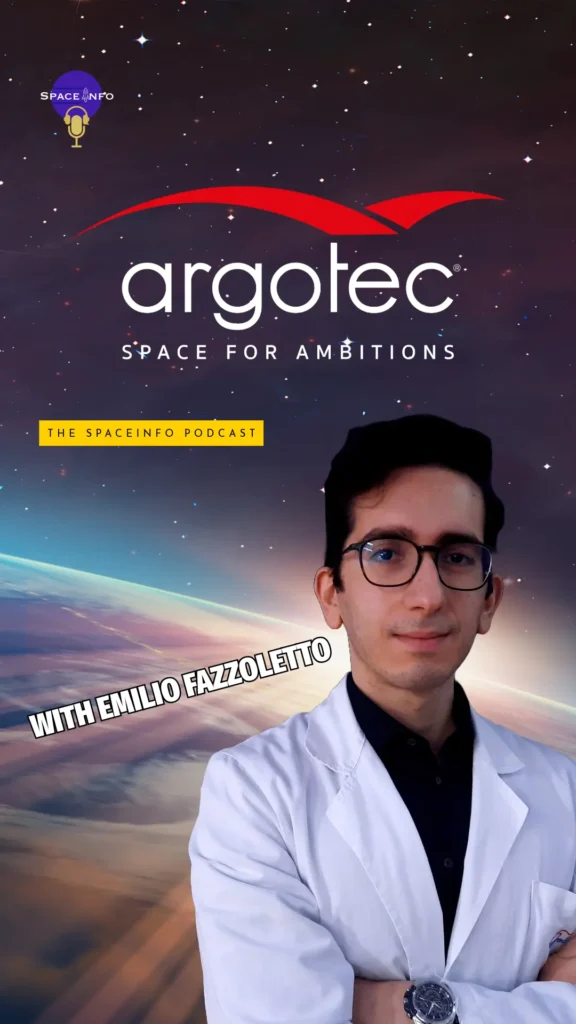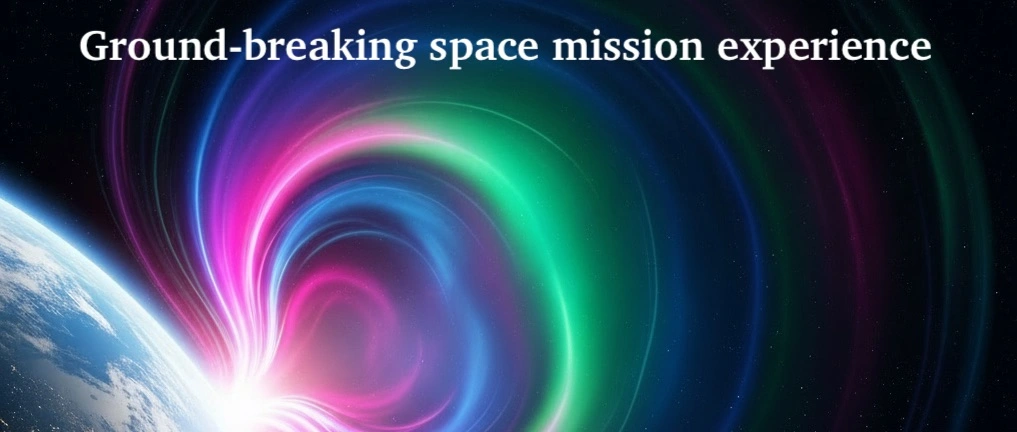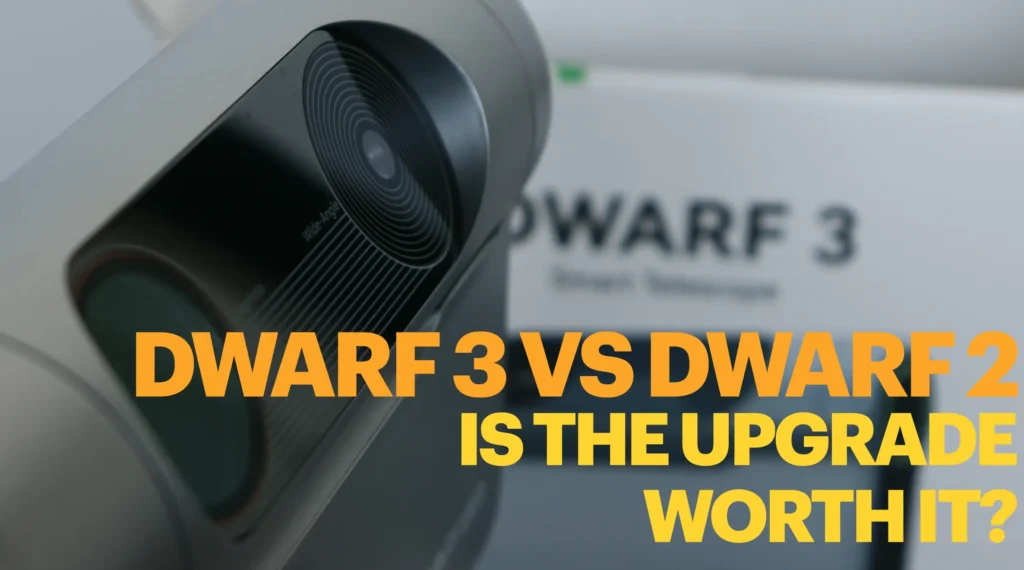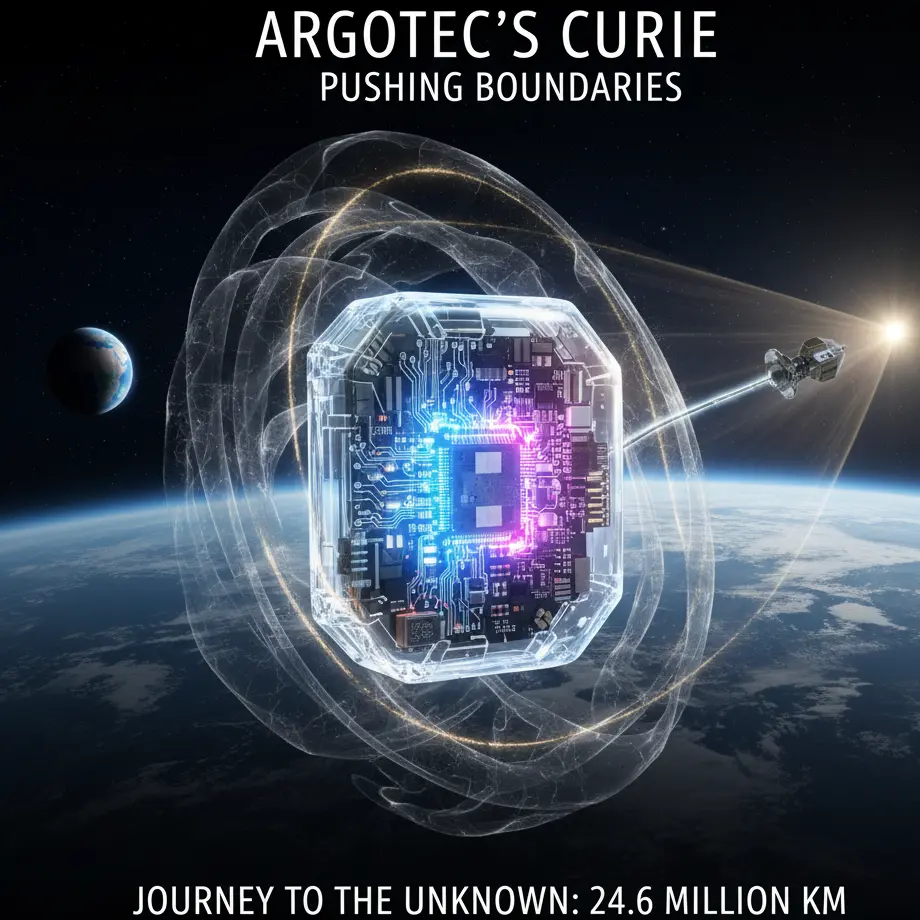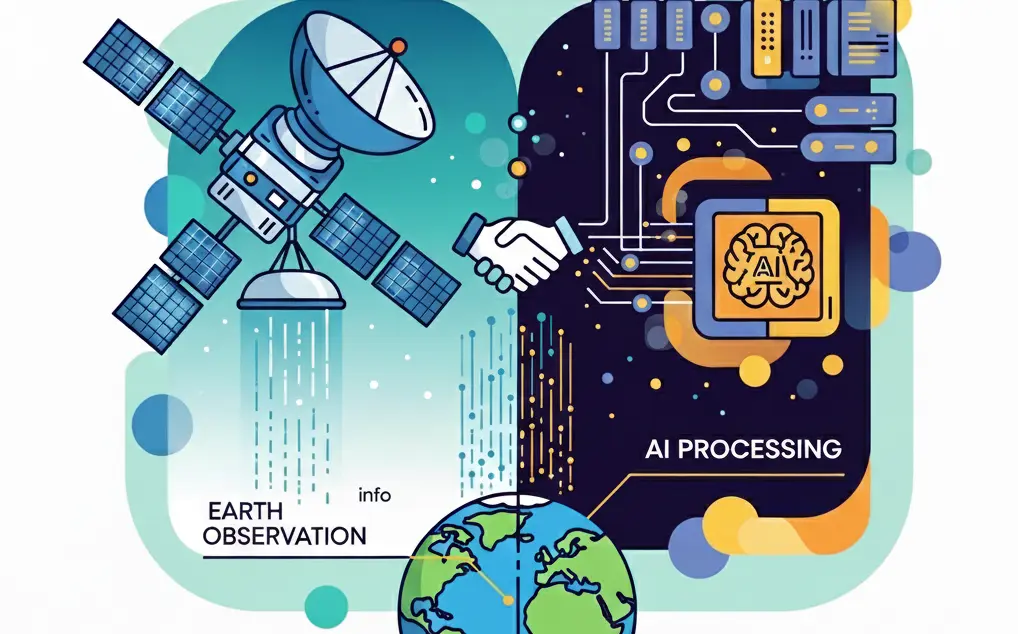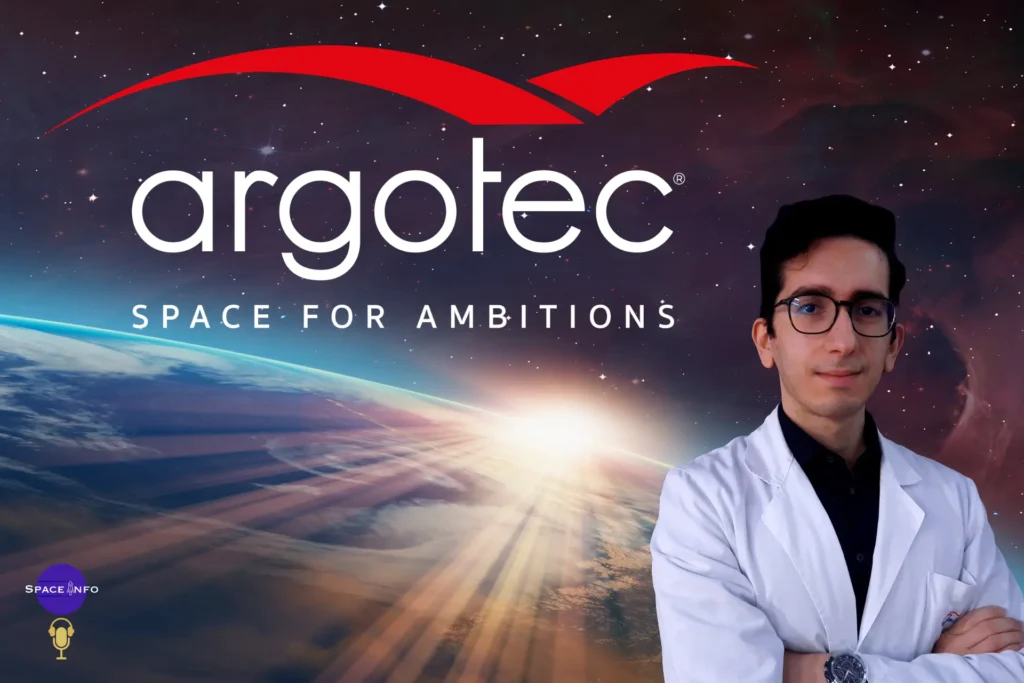
EMILIO FAZZOLETTO
Bringing Italian Space Technology to the furthest outpost
The SpaceInfo Club had the pleasure to talk with the people working in a highly innovative and steeply growing Italian Space Company based in Turin: ARGOTEC. So, thanks to Xavier Bellanca, Communication Officer, we could ask Emilio Fazzoletto, Head of Electronics Unit some questions.
This interview has been taken from the SpaceInfo Podcast, where the full episode is available. You can listen it on Spotify, YouTube and all the major streaming platforms.
Enjoy the read!
Emilio, what is Argotec for the people who don’t know it? What do you do here?
So, Argotec is an Italian aerospace company, now also active on the US market. And I’m an electronic engineer. I joined Argotec in 2016. Since then, I mainly worked in the avionics unit of the company. So, we design small satellites, among other things. So, I contributed to the development of the avionics subsystems that we use on our satellites. And now I’m leading the electronics unit and I’m also working in product management for the company. Especially in the beginning, when I joined, the company was still quite small. We were 15-20 people in 2016. Now we are more than 160.
When you are a few, you have to do many things. But then, let’s say, we became now a middle-sized company. So, now I have a lot of wonderful colleagues that I can share the workload with.
But especially in the beginning, I had the chance to work on many, many things.
Notice Title
ARGOTEC: about the Company
Argotec is an Italian aerospace company specializing in the design, development, and operation of space systems and payloads. Founded in 2008 and headquartered in Turin, Italy, Argotec has emerged as a key player in Europe’s space industry.
The company’s focus spans various aspects of space missions, including spacecraft and payload design, integration, and operation. Argotec provides services to both institutional and commercial customers, contributing to a wide range of space projects.
One of Argotec’s notable achievements is its involvement in the development and operation of space experiments for the International Space Station (ISS). They have designed and managed payloads that have been sent to the ISS, conducting scientific research in microgravity environments.
Argotec’s expertise also extends to satellite technology, including small satellite systems for Earth observation, telecommunications, and scientific research. The company is known for its innovative approach to space technology, often leveraging advancements in miniaturization and efficient mission design.
Collaboration is a key aspect of Argotec’s operations, working closely with space agencies, research institutions, and industry partners both in Italy and internationally. By collaborating with various stakeholders, Argotec aims to contribute to the advancement of space exploration and scientific discovery.
Overall, Argotec plays a significant role in Italy’s space sector and contributes to Europe’s broader efforts in space exploration and technology development.
So, you mentioned that you are both working on electronics and avionics, and product management. Which is your favorite field?
I’m definitely a product guy. I remember already at the university, pushing as much as possible to do product development courses. Because I really like, let’s say, all the journey of a product.
From the customer needs up to the delivery of the actual product. And here in Argotec, I was lucky because we are not just a satellite integrator, but we build our own technology. In terms of hardware, software, services, subsystems, satellites.
So, we built many, many products in the last 7-8 years. And I had the chance to, let’s say, follow a few of them during their life cycle. Up to the flights and very successful missions.
One of the most successful missions so far is LICIA Cube, something very unique…
With Licia Cube, we actually performed an asteroid mission with a CubeSat, something that was, let’s say, never attempted. CubeSats usually were used just in low Earth orbit with simple missions. And you can use the commercial parts for that.
And we did it actually. We started from technology used for interplanetary spacecraft that usually are hundreds of kilograms or a few tons in mass. And we downsized them down to CubeSat compatible form factors.
So that was one of the big challenges that that we faced. But it was crucially important for us because it enabled new frontiers. For example, with Licia Cube, it was about a scientific mission on an asteroid.
But for the future, it will be about providing services in remote locations like the Moon, Mars and having a look at the launch costs for remote locations like the Moon and Mars. We are talking about extremely high numbers, hundreds of thousands of euros per kilogram, for example, around the Moon, which is a completely different economic environment with respect to the Earth. And so, for example, the kind of technology that we developed for Licia Cube isn’t really an enabler with respect to the sustainability of services, for example, in this case, beyond the Earth orbit.
It's about providing services and I can't wait to show you what we can deliver with our constellation!
Embracing the Cosmos: World Space Week 2025 & SpaceInfo Club’s Mission
Leicester Scientists Bring Space Exploration to London as Cutting-Edge Telescope Joins SMILE Mission
A Cosmic Accident Solves Jupiter & Saturn’s Silicon Mystery
DWARF 3 vs DWARF 2 Smart Telescope: Is the Upgrade Worth It?
Argotec’s CURIE: The Electric Heart Driving Small Satellites to the Edge of the Unknown
Argotec and UniBap Forge Strategic Partnership to Power Next-Generation Satellite Missions
Which are the differences between you and the other companies that you see as a strength point?
We started new product lines that were not existing on the market.
So we developed the technology to execute deep space mission, robotic exploration of remote bodies with small satellites. The Licia Cube mission launched almost three years ago.
So and it enabled something new. Licia Cube also won the mission of the year award. It was the first SmallSat ever to operate next to an asteroid.
It was also the first fully Italian interplanetary probe. And so we have these capabilities regarding technology for small satellite able to operate in a very hostile environment, but also able to operate with high autonomy. One other thing that we pushed a lot in the past and we keep pushing is the onboard autonomy, the onboard processing, the capability of the satellite to face unscripted scenarios, things that cannot be predicted in advance and to operate accordingly with onboard intelligence.
This was crucial for each of you. And this is crucial for a number of other applications. So what I think is that we are in a unique position thanks to the technology, the product that we developed and the service we are developing now that can be reused in a wide variety of application.
I talked about the moon. I talked about Mars. But also think about Earth orbits like MEO, GEO orbit or more generally, defense applications.
I would say that the avionics is the systems, that part of the satellite, correct me if I’m wrong, that allows it to be controlled and to have data on board to be processed. And everything that is about satellite, let’s say, management, what it can do and how it can be done, is controlled by the avionics. Is it right?
Yes, absolutely. For example, we develop onboard computers, which are, let’s say, the core of the satellite. In terms of, let’s say, intelligence, autonomy.
So, the onboard computer has a lot of sensors, talk with all the subsystems that we have in the satellite, in order to understand the status of the spacecraft and to execute the mission in the different operative modes. And let’s say it takes care of the spacecraft health and it takes care of executing mission sequences. Or, for example, another important avionics system we work on are the transponders.
Basically, the radio that we use to communicate between Earth and the satellites. And this is another crucial piece of equipment, because without communication, it would be impossible to do anything with the satellites. And we develop internally this kind of subsystem, especially for small platforms.
So, let’s say we also have the added difficulty of keeping equipment that usually can weigh tens of kilograms and can be quite bulky. And reduce that down to something like 300 grams so that you can have it in your hands.
What is ‘Responsive Space’?
One important thing in the industry is about responsive space. It’s something that is discussed a lot, both in private commercial markets, but also about the defense application with the changing political environment. And so having a supply chain, an active supply chain with the capability also to produce in-house.
And at the space park, we are not talking just about assembling satellite at the space park. We are talking about assembling complex electronic on site. We are talking about producing mechanical parts.
We are talking about controlling missions from our mission control center, developing digital twins, machine learning models, having the whole chain almost from the raw material to the deployment of the service. And the operation of the service help us to answer to the request that we have of shorter and shorter time: from the start of the project to the commissioning of the service.
Also I would add that Constellation applications come into play now… maybe you’ve been following the SpaceInfo Club and you already know that some time ago we talked with the IRIDE Space Program Team. How are you involved into this?
We are involved up to the end of my hair! It’s a program we are working on very hard. Of course, as our readers know, it is a constellation of constellation built for the Italian government.
And it’s mainly about Earth Observation. So we are one of the companies that are developing part of this system of constellations. And in particular, we are working with satellites around 65 kilogram with multispectral sensors.
We already built the very first satellite of the whole constellation. Now we are working on the other ones. We have a first batch of 10 satellites that will be completed within this year.
On the other end, at Argotec, we are starting to operate at constellation scale. So we are going to have a throughput of 10 satellites this year, 15 the next one. And our new factory, the Space Park, will be capable to handle one satellite per week.
We are going to be at one satellite per week and this is an enabler for constellations, because you don’t want to deploy a constellation over the years, because at that point the first satellites are going to be at the end of their life. So it is definitely an enabler to build the constellation systems with high performance in a reasonable amount of time.
It will be about cost because it will make satellite more similar to industrial applications, industrial product and less similar to special platforms. Even if, as I was saying, we are still working with NASA, because they are very important to advance our technology and stay on the top notch of the market. It will also be about timing.
Which is the sustainability approach and how do you see sustainability in general for satellites?
It’s about disconnecting properly the battery from your satellite, depleting the battery in order to guarantee that it will not explode like some smartphones two years ago… And it’s something that is not trivial, because if you think usually you design the satellite to not be disconnected from your power source.
You design the satellite to be robust and resilient with respect to everything that can happen, you try to design something that for five years has to do everything it can in order to work reliably. And then with the same reliability as to completely disable itself for the next 25 years, guaranteeing that no matter what you do, it will not turn on again.
It’s, let’s say, not trivial, but it was, for example, one of the projects that we developed for the European Space Agency together with a partner in the UK. And again, this is about what I was saying regarding the collaboration between something that you can do with an agency for a scientific mission, but something then that you can also use for commercial services. And this is also the European Space Agency.
The Italian Space Agency are working in this direction as well. And we are doing our best to leverage as much as possible these kind of opportunities.
